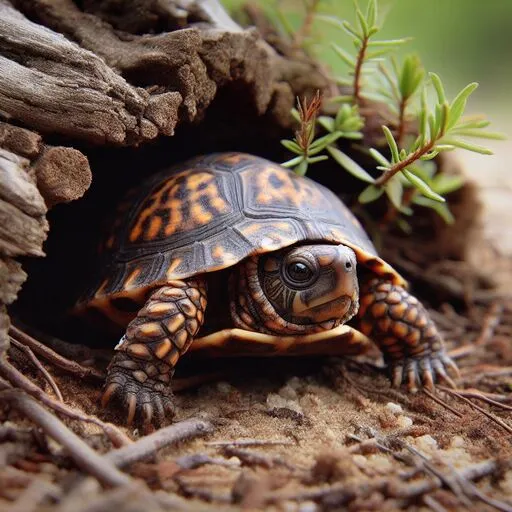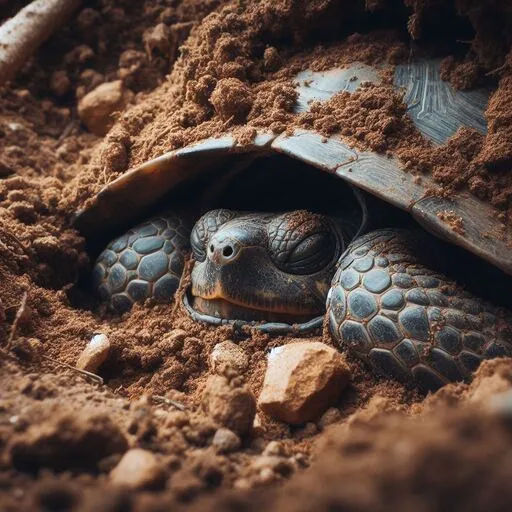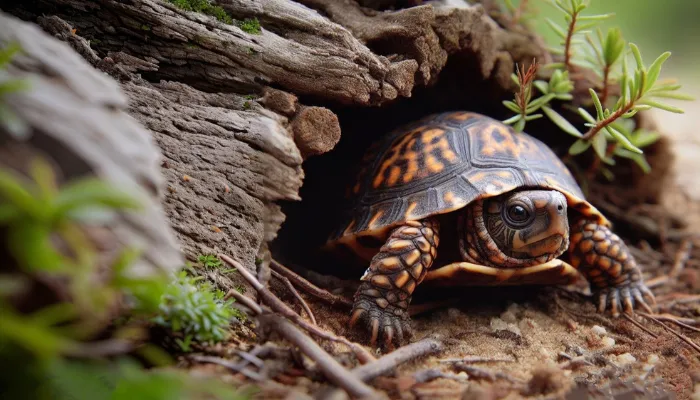Box turtles, just like many other reptiles, go through a hibernation period during the colder months.
For the sake of your pet’s wellbeing, make sure it has a good hibernation.
We’ll go over important care instructions for box turtle hibernation in this post, so you can help yours hibernate safely and comfortably through the winter and help it return to being an active member of the species.
Understanding Box Turtle Hibernation
Why Box Turtles Hibernate

Hibernation is a natural survival strategy for box turtles.
As cold-blooded animals, they need to conserve energy when temperatures drop, and food becomes scarce.
By hibernating, they slow down their metabolism and reduce their activity, allowing them to survive the winter months with minimal energy expenditure.
Recognizing the Signs of Hibernation
Before your box turtle enters hibernation, you may notice some changes in its behavior. These can include:
- Decreased appetite
- Sluggish movement
- Seeking a hiding spot
These signs indicate that your turtle is preparing for its winter rest and that it’s time to set up the ideal hibernation environment.
Box Turtle Species and Hibernation Differences

Understanding the differences between various box turtle species is essential for providing the appropriate care during hibernation.
Each species has unique characteristics and habitat preferences that can affect their hibernation requirements.
Eastern Box Turtles

Eastern box turtles are native to the eastern United States and are commonly found in deciduous forests.
They usually hibernate from late October or early November until March or April.
Eastern box turtles dig shallow burrows in leaf litter or soil to hibernate.
They prefer hibernation temperatures between 45°F and 50°F (7°C and 10°C).
Ornate Box Turtles

Ornate box turtles inhabit the grasslands and prairies of the central United States.
Their hibernation period is similar to that of Eastern box turtles, typically from October or November to March or April.
Ornate box turtles burrow deeper into the soil than Eastern box turtles, sometimes reaching depths of 6-12 inches.
They can tolerate slightly lower temperatures, around 40°F to 50°F (4°C to 10°C).
Three-Toed Box Turtles

Three-toed box turtles are native to the south-central United States, where they inhabit forests, grasslands, and wetlands.
Their hibernation period usually starts in November and ends in March.
Like other box turtle species, they dig burrows to hibernate, with temperatures ranging from 45°F to 55°F (7°C to 13°C).
Desert Box Turtles

Desert box turtles inhabit the arid regions of the southwestern United States and northern Mexico.
They hibernate from November to February or March, depending on local temperatures.
Desert box turtles prefer to hibernate in well-drained sandy or rocky soils.
They can tolerate slightly higher hibernation temperatures, around 50°F to 60°F (10°C to 15°C).
It’s important to research the specific needs of your box turtle species to provide the most suitable hibernation conditions.
Always consult with a reptile veterinarian or an experienced box turtle keeper for guidance on the best practices for your pet’s hibernation.
Preparing for Hibernation
Health Check
A pre-hibernation health assessment is essential to ensure your turtle is in good condition before entering its winter rest.
Signs of a healthy turtle ready for hibernation include:
- Clear eyes and nostrils
- Healthy shell without cracks or discoloration
- No signs of parasites or infections
If you’re unsure about your turtle’s health, seek guidance from a reptile specialist for a thorough examination.
Creating the Ideal Hibernation Environment
To ensure your box turtle has a safe and comfortable hibernation, consider the following factors:

Location: Choose a quiet, dark, and draft-free area for your turtle’s hibernation enclosure.
Temperature: Maintain a temperature between 45°F and 60°F (7°C and 15°C) for optimal hibernation conditions.
Humidity: Keep the humidity level around 70% to prevent dehydration.
Hiding spot: Provide a secure and comfortable hiding spot, such as a burrow or a box filled with substrate, for your turtle to retreat to during hibernation.
Feeding and Hydration Before Hibernation
Before your box turtle enters hibernation, it’s important to ensure it has received proper nutrition and hydration.
In the weeks leading up to hibernation, offer your turtle a variety of nutrient-rich foods, such as leafy greens, vegetables, fruits, and insects.
Also, provide a clean and shallow water dish for your turtle to drink from and soak in.
Indoor vs. Outdoor Hibernation
Choosing the right hibernation setup for your box turtle is crucial for its health and safety.
Both indoor and outdoor hibernation setups have their advantages and disadvantages.
It’s essential to weigh these factors and consider your turtle’s specific needs before deciding on the most suitable option.
Indoor Hibernation Setups
Indoor hibernation setups can provide a controlled environment for your box turtle.
You can use a separate container, such as a plastic storage bin or an aquarium, filled with a suitable substrate like coconut coir or peat moss.
Ensure that the enclosure has proper ventilation, temperature, and humidity levels.
Pros of indoor hibernation:
- Greater control over environmental conditions
- Easier monitoring of your turtle’s health and safety
- Protection from predators and extreme weather
Cons of indoor hibernation:
- Requires space for a separate hibernation enclosure
- May need additional equipment, such as heaters or humidifiers, to maintain optimal conditions
- Can be challenging to replicate natural hibernation conditions
Outdoor Hibernation Setups
Outdoor hibernation setups allow your box turtle to hibernate in a more natural environment.
You can create a designated hibernation area within your turtle’s outdoor enclosure by providing a suitable burrowing substrate and a shelter, such as a wooden box or a pile of leaves.
Pros of outdoor hibernation:
- More natural hibernation experience for your turtle
- No need for a separate indoor enclosure
- May require less equipment and maintenance
Cons of outdoor hibernation:
- Less control over environmental conditions
- Increased risk of predation or extreme weather events
- Requires a secure and well-designed outdoor enclosure
Pros and Cons of Indoor and Outdoor Hibernation
When deciding between indoor and outdoor hibernation setups, consider factors such as your local climate, available space, and your ability to monitor and maintain the hibernation environment.
It’s crucial to choose the option that best meets your turtle’s needs and ensures its safety and well-being during hibernation.
If you’re unsure about which option is best for your box turtle, consult with a reptile veterinarian or an experienced box turtle keeper for guidance.
They can help you assess your specific situation and recommend the most suitable hibernation setup for your pet.
Caring for Your Hibernating Box Turtle
Monitoring Your Turtle’s Health

While your box turtle is hibernating, it’s essential to keep an eye on its health.
Regularly check for signs of distress or illness, such as:
- Unusual odors or discharge
- Swelling or discoloration of the skin or shell
- Rapid weight loss
Should you observe any of these symptoms, it’s crucial to talk to a herpetologist or an experienced box turtle keeper right away.
Maintaining the Hibernation Environment
During your turtle’s hibernation, ensure its environment remains safe and clean.
Regularly check the temperature and humidity levels and adjust them as needed.
Remove any waste or debris from the enclosure to prevent the growth of bacteria or mold.
Preventing Pests and Parasites
Pests and parasites can pose a risk to your hibernating box turtle.
To minimize this risk, ensure the hibernation enclosure is clean and secure.
Regularly inspect the enclosure for signs of pests, such as ants, mites, or rodents, and take appropriate action if necessary.
Common Hibernation Problems and Solutions

Box turtles may face several challenges during hibernation.
As a responsible pet owner, it’s essential to be aware of these issues and take the necessary steps to address them.
Here are some common hibernation problems and their solutions:
Dehydration During Hibernation
Dehydration can be a significant issue for hibernating box turtles.
Although their metabolism slows down during hibernation, they still need to maintain proper hydration levels.
Solution: To prevent dehydration, ensure that the hibernation substrate is slightly damp but not wet.
Regularly check the humidity levels in the hibernation enclosure and adjust as needed.
In an outdoor hibernation setup, make sure the burrow doesn’t become waterlogged or too dry.
Insufficient Weight Gain Prior to Hibernation
Box turtles need to store enough energy reserves before hibernation to sustain them throughout the winter months.
Insufficient weight gain can lead to health issues during and after hibernation.
Solution: In the weeks leading up to hibernation, provide your box turtle with a variety of nutrient-rich foods, such as leafy greens, fruits, and insects.
Monitor your turtle’s weight and consult a reptile veterinarian if you’re concerned about its weight gain or overall health.
Overheating or Freezing During Hibernation
Maintaining the appropriate temperature range during hibernation is crucial for your box turtle’s health.
Overheating or freezing can cause severe stress and health problems.
Solution: Regularly monitor the temperature in your turtle’s hibernation enclosure and adjust it as needed.
For indoor hibernation setups, use a thermostat-controlled heating device to maintain a consistent temperature.
In outdoor setups, ensure the hibernation area is well-insulated and protected from extreme temperature fluctuations.
By being proactive and addressing these common hibernation problems, you can help ensure a safe and healthy hibernation experience for your box turtle.
Always consult with a reptile veterinarian if you have concerns about your turtle’s health or hibernation conditions.
Waking Up from Hibernation
Your Box Turtle is Ready to Wake Up

When the temperatures begin to rise, and spring approaches, your box turtle will start showing signs that it’s ready to wake up from hibernation.
These can include:
- Increased movement and responsiveness
- Appetite returning
Helping Your Turtle Transition Out of Hibernation
To ease your box turtle back into its active state, follow these steps:
- Gradually increase the temperature and light in the enclosure over several days.
- Offer fresh water and a variety of nutrient-rich foods to help your turtle regain its strength.
- Monitor your turtle’s health and behavior closely during this transition period.
Post-Hibernation Health Check
Once your box turtle has fully emerged from hibernation, it’s important to assess its health.
Check for any signs of illness or injury that may have occurred during hibernation.
If you notice anything unusual or concerning, reach out to a vet experienced in reptile care for advice.
Post-Hibernation Care
Once your box turtle has emerged from hibernation, it’s crucial to provide the proper care to help it transition back to its active state.
Here are some essential steps to follow during the post-hibernation period:
Reintroducing Your Turtle to Its Regular Habitat
After hibernation, gradually reintroduce your box turtle to its regular habitat.
For indoor turtles, increase the temperature and light in the enclosure over several days to mimic the natural progression of spring.
For outdoor turtles, ensure the outdoor enclosure is clean and secure, and monitor the weather conditions to prevent exposing your turtle to extreme temperatures or heavy rain.
Reestablishing a Feeding Schedule
Your box turtle’s appetite will gradually return after hibernation.
Begin by offering small amounts of food and gradually increase the portions over several days.
Provide a variety of nutrient-rich foods, such as leafy greens, fruits, and insects, to help your turtle regain its strength.
Make sure to also provide clean, fresh water for drinking and soaking.
Monitoring Your Turtle’s Health After Hibernation
Closely monitor your turtle’s health during the post-hibernation period.
Check for any signs of illness or injury that may have occurred during hibernation, such as:
- Lethargy or weakness
- Discharge from the eyes, nose, or mouth
- Swelling or discoloration of the skin or shell
- Changes in appetite or weight
If you notice anything unusual or concerning, consult a reptile veterinarian for advice.
They can help assess your turtle’s health and recommend any necessary treatments.
By providing attentive post-hibernation care, you can help your box turtle transition back to its active state and ensure its health and well-being throughout the year.
Remember to contact a reptile expert for advice if you have any concerns or questions about your pet’s care.
Conclusion
Your box turtle’s health depends on a healthy hibernation. Knowing how a pet hibernates, setting up the perfect habitat, and giving it your whole attention will help you make sure your pet sleeps through the winter safely and comfortably during its box turtle hibernation.
Always keep an eye on your turtle’s health throughout the hibernation period and be prepared to assist it in transitioning back to its active state when the time arrives.










